Finding the best lock for your bicycle can feel overwhelming. The market is flooded with options, and making the wrong choice can lead to devastating consequences – bike theft.
The key to effective bike security isn’t just about brute strength; it’s about finding a lock that’s both secure enough to deter thieves and practical enough for you to use every single day.
This crucial balance between robust security and everyday usability is what I prioritize. Having tested bike locks and written about bicycle security since 2015, I understand what truly matters in bike protection.
Based on rigorous security assessments and real-world user testing, I recommend 6 of the Best Bike Locks below, categorized by their security level and usability.
If none of these initial recommendations perfectly match your needs, don’t worry! Further down, I’ll guide you through three simple steps (including a helpful risk assessment quiz) to ensure you discover the ideal bike lock tailored to your specific requirements.
1. Litelok X1
The Litelok X1 stands out as the best all-around bike lock in 2024. Its exceptional feature? It’s one of the few bike locks offering genuine protection against thieves armed with cordless angle grinders.
In 2024, the Litelok X1 remains unique in its ability to balance angle grinder resistance with practicality and reasonable pricing, making it ideal for cyclists needing enhanced security.
Angle grinder attacks have become alarmingly frequent in many areas, sadly becoming a primary method for stealing bikes not secured with flimsy cable locks.
Until recently, no bike lock could withstand an angle grinder for more than a minute. Locks like the Litelok X1 and the Hiplok D1000, capable of resisting these attacks, are increasingly vital.
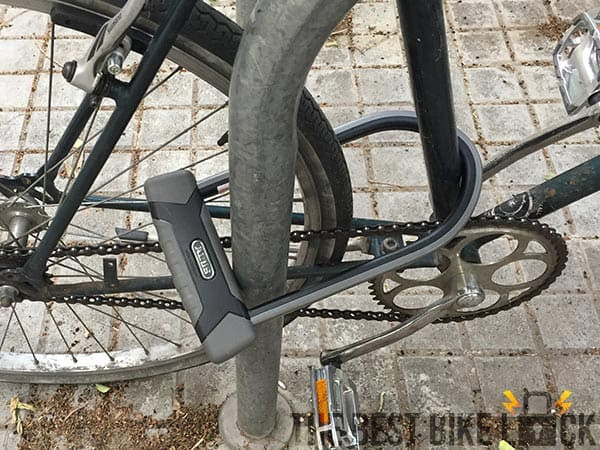 Litelok X1 on front wheel
Litelok X1 on front wheel
Litelok X1 securing a bicycle wheel, highlighting its robust design and ease of use as a top-rated bike lock.
What sets the Litelok X1 apart?
The Litelok X1 maintains the familiar form and function of a traditional u-lock. While slightly shorter than standard u-locks by less than 2 cm, this difference is negligible in practical use.
The key innovation lies in the Litelok X1’s 16 mm shackle, which is fused with a ceramic composite material. This specialized material effectively wears down angle grinder discs as they attempt to cut through the lock.
Close-up of the Litelok X1, showcasing its durable shackle and highlighting its status as a highly secure bike lock.
| Litelok X1 | |
|---|---|
| My score: | |
| Check price: | > Check Litelok X1 Price |
| Shackle thickness: | 16 mm |
| Weight: | 3.7 lb (1.7 kg) |
| Size (internal): | 3.97 x 7.7″ (10.1 x 19.6 cm) |
| Other Security Ratings: |
In my own security tests, cutting through just one side of the Litelok X1 took over four times longer than the Kryptonite New York Fahgettaboudit, previously considered the most secure bike lock.
In fact, during my initial test, all my cutting discs were completely worn out before I could even cut through the first side of the Litelok X1, rendering it effectively undefeatable.
The Litelok X1’s impressive performance is widely recognized. It’s among the select few bike locks, including other angle grinder resistant models, to achieve a Sold Secure Powered Cycle Diamond rating.
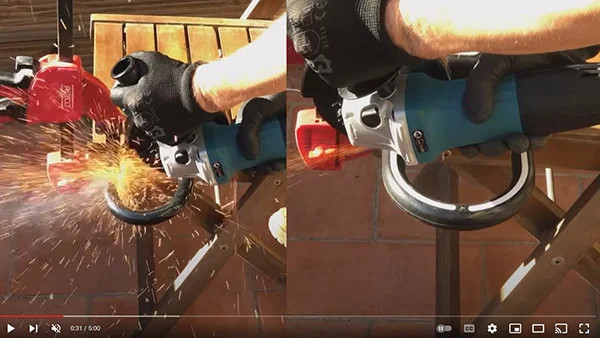 Litelok X1 test video still
Litelok X1 test video still
Video still from an angle grinder resistance test of the Litelok X1, demonstrating its robust security features as a leading bike lock.
Is the Litelok X1 flawless? Not quite.
My initial Litelok X1 unit was slightly stiff to lock (a problem quickly resolved with a simple DIY fix, and reportedly corrected in later factory production).
More importantly, while highly secure, it doesn’t surpass the Hiplok D1000 (and DX1000), or the Litelok X3 in angle grinder resistance. These models took 2.5 and 3 times longer to cut through, respectively.
So why isn’t the Hiplok D1000 or Litelok X3 my top recommendation for 2024? Both are exceptional locks and currently represent the pinnacle of bicycle security.
 Litelok X1 vs Litelok X3 vs Hiplok D1000
Litelok X1 vs Litelok X3 vs Hiplok D1000
Comparison image of Litelok X1, Litelok X3, and Hiplok D1000, illustrating the range of high-security bike lock options available.
However, their price points are considerably higher. They are also significantly heavier and less portable than the Litelok X1. Additionally, the Hiplok D1000’s smaller size compared to the Litelok X1 might limit its usability for some cyclists (though the Hiplok DX1000 addresses this).
The Litelok X1 strikes an optimal balance of security, usability, and price.
Its practical size, convenient frame mount, and competitive price (only slightly more expensive than the Abus Granit X Plus 540 and nearly half the price of the Hiplok D1000!) make the Litelok X1 a sensible choice for most cyclists seeking angle grinder resistant protection.
For a deeper dive, read my comprehensive Litelok X1 review (including a video comparing its angle grinder resistance to the Fahgettaboudit) or my comparison of the Litelok X1 vs Hiplok D1000.
Keep an eye on my page dedicated to angle grinder resistant bike locks, as new models are constantly being developed!
2. Kryptonite Kryptolok New-U
Angle grinder resistance isn’t essential for everyone. Again, I recommend taking my brief 3-question risk assessment quiz to determine your specific risk level and whether you truly need angle grinder protection.
For those who don’t require that level of security, the Kryptonite Kryptolok New-U (an enhanced version of the popular Kryptolok Series 2) is an excellent and affordable alternative.
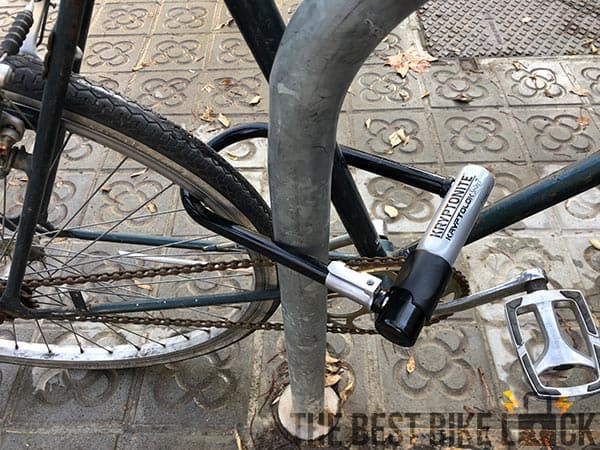 Kryptonite Kryptolok Standard: best medium security bike lock
Kryptonite Kryptolok Standard: best medium security bike lock
Kryptonite Kryptolok Standard securing a bicycle wheel, emphasizing its medium security and practical design as a reliable bike lock.
By upgrading the shackle to lock on both sides, the Kryptolok New-U has achieved a Sold Secure Gold rating, up from Silver. However, its ART 2/5 star rating indicates it remains firmly in the medium-security category.
The standout feature of the Kryptolok is its ease of use.
It’s relatively lightweight (comparable to 3.5 cans of soda). With proper frame mount installation, it’s easily portable during rides.
Its generous size provides ample flexibility in finding secure locking locations.
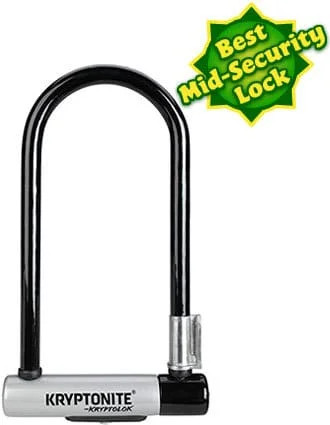 Kryptonite Kryptolok New-U best mid-security lock
Kryptonite Kryptolok New-U best mid-security lock
Kryptonite Kryptolok New-U in a product shot, highlighting its features as a best mid-security bike lock with a balance of security and usability.
| Kryptonite Kryptolok New U | |
|---|---|
| My score: | |
| Check price: | > Check Amazon Price |
| Shackle thickness: | 12.7 mm |
| Weight: | 2.9 lb (1.32 kg) |
| Size (internal): | 4 x 9″ (10.2 x 22.9 cm) |
| Kryptonite rating: | 6/10 |
| Other Security Ratings: |
While I prefer the keyhole covers found on OnGuard locks for improved disc alignment, it’s a minor point (and OnGuard mechanisms are generally less secure).
Kryptonite’s customer service is undeniably superior among bike lock brands. This translates to numerous benefits, including free key replacements and reduced-price (or even free) lock replacements under certain conditions.
For enhanced Kryptonite security, consider their Evolution range. However, these will be heavier or smaller and still lack angle grinder resistance.
If your risk environment is lower, the Kryptonite Kryptolok offers user-friendly operation and adequate protection at a very reasonable price.
Read my in-depth, hands-on Kryptolok review, which includes recommendations for alternatives if it’s not the right fit for you.
3. Foldylock Compact
Folding locks are gaining popularity as a versatile alternative to traditional bike locks. They are generally more portable and offer greater locking flexibility. However, the selection of truly secure folding locks is limited.
Fortunately, some folding locks are definitely worth considering.
The Foldylock Compact is the lightest folding lock that still provides a respectable level of security (Sold Secure Silver). Furthermore, in my testing, it’s the most user-friendly folding lock available.
 Foldylock Compact: lightest folding lock
Foldylock Compact: lightest folding lock
Foldylock Compact securing a bicycle wheel, showcasing its lightweight design and practicality as a folding bike lock.
The Foldylock Compact extends to 33″ (85 cm), offering similar internal locking space to a standard u-lock.
Its flexible design expands your locking options considerably.
Weighing just 2.2 lb (1 kg), it’s barely heavier than 2.5 cans of soda. For even greater portability, a slightly shorter (75 cm) version is available, including a belt clip option forgoing the frame mount entirely.
Foldylock Compact folded and mounted, demonstrating its compact form factor and convenient portability as a folding bike lock.
| Foldylock Compact | |
|---|---|
| My score: | |
| Check price: | > Check Amazon Price |
| Plate thickness: | 5 mm |
| Weight: | 2.2 lb (1 kg) |
| Length: | 33″ (85 cm) |
| Foldylock rating: | 14/18 |
| Other Security Ratings: |
Compared to the Abus Bordo 6000, its closest competitor (until the Abus lost its Sold Secure Silver rating), the Foldylock Compact is lighter and more user-friendly.
It’s easier to unlock, unfold, maneuver around your bike, and boasts a superior frame mount. Plus, it’s typically more affordable! Check the Amazon price for current pricing.
If you’re in a lower-risk area and seek a compact, flexible, and lightweight alternative to a u-lock, this is an excellent choice.
Read my hands-on review of the Foldylock Compact, which also suggests alternatives if it’s not the ideal lock for you. Or explore more of the best lightweight bike locks.
4. Foldylock Forever
Foldylock also offers a high-security folding lock, the Foldylock Forever, a robust, heavy-duty version of their standard folding locks (Classic, Compact, Mini, etc.).
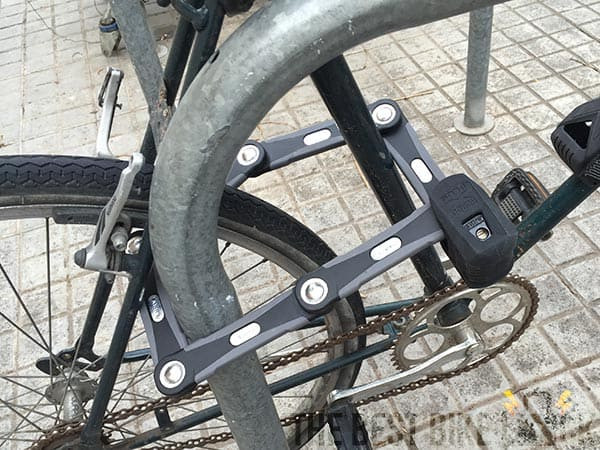 Foldylock Forever around traffic light
Foldylock Forever around traffic light
Foldylock Forever secured around a traffic light, illustrating its extended length and flexibility for versatile locking options as a high-security folding bike lock.
Measuring 35.4″ (90 cm), slightly longer than the Foldylock Compact, it offers extensive locking possibilities (as seen above, easily fitting around a traffic light, impossible with a u-lock).
Crucially, its arms are 6.5 mm thick (compared to 5 mm on standard Foldylocks). This extra 1.5 mm contributes to its Sold Secure Gold rating (versus Silver for other Foldylocks).
The Foldylock Forever arms are also 1 mm thicker than other Sold Secure Gold-rated folding locks (including the Abus Bordo 6500, Trelock FS 500 Toro, and Kryptonite Evolution 790).
This enhanced thickness is coupled with a patented rivet protection system to deter nut splitter attacks, although such attacks are uncommon on the street but are a known vulnerability of locks like the Abus Bordo 6500.
These added security features make the Foldylock Forever the most secure folding lock currently available, and the only folding lock secure enough for mopeds and scooters in addition to bicycles!
Foldylock Forever in a product shot, emphasizing its high-security features and robust construction as a top-tier folding bike lock.
| Foldylock Forever | |
|---|---|
| My score: | |
| Check price: | > Check Amazon Price |
| Plate thickness: | 6.5 mm |
| Weight: | 3.88 lb (1.76 kg) |
| Length: | 35.4″ (90 cm) |
| Foldylock rating: | 18/18 |
| Other Security Ratings: |
This high security comes with a weight penalty. At 3.88 lb (1.76 kg), it’s a heavier lock, weighing slightly more than 4.5 cans of soda.
However, like all Foldylocks, usability is a strength. It’s easy to unlock, unfolds and refolds smoothly, and offers more internal locking space than a standard u-lock, providing numerous locking options.
While some reviews suggest the lock may fit too tightly or loosely in its mount, I experienced neither issue. Like the Classic, the Forever slides smoothly in and out of the plastic mount, remaining snug and secure without rattling during rides.
Although not inexpensive, Amazon prices typically show it cheaper than the Abus Bordo 6500 and other high-security folding locks. Read my detailed, hands-on Foldylock Forever review for more information.
5. Kryptonite Kryptolok 955 Mini
For those preferring a traditional bike lock style, the Kryptonite Kryptolok Series 2 955 Mini is a short, medium-security chain lock designed for portability.
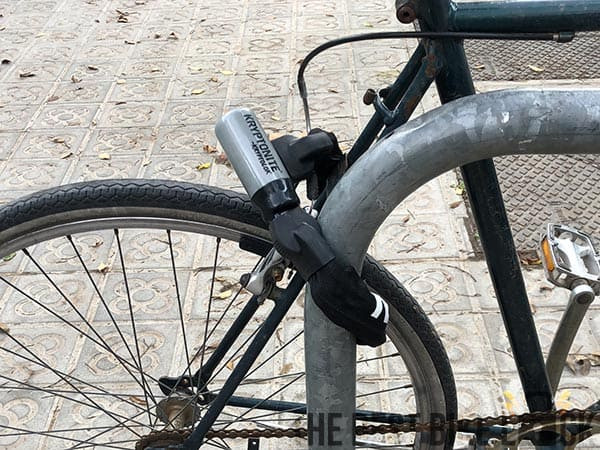 Kryptonite Kryptolok 955 Mini: best medium security chain lock
Kryptonite Kryptolok 955 Mini: best medium security chain lock
Kryptonite Kryptolok 955 Mini securing a bicycle frame, demonstrating its portability and practicality as a medium-security chain lock.
When locked, it offers slightly less internal space than a standard u-lock, but its flexibility provides many more locking possibilities.
Like all chains, it’s heavier than a u-lock of comparable security (weighing about the same as 4.5 cans of soda), but still light and short enough to carry wrapped around your seat post or in a bag.
The integrated locking mechanism streamlines the locking process compared to chains with separate padlocks.
With 9 mm links, it’s not the most secure bike lock, but it holds a Sold Secure Gold rating and offers significantly more protection than any cable lock.
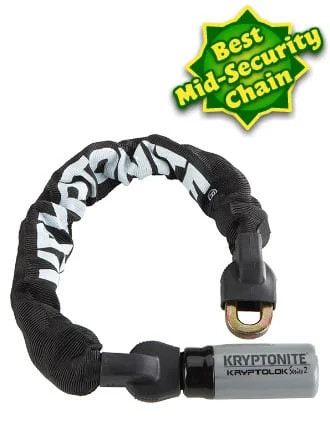 Kryptonite Krptolock Series 2 955 Mini best mid-security chain
Kryptonite Krptolock Series 2 955 Mini best mid-security chain
Kryptonite Kryptolok Series 2 955 Mini in a product shot, highlighting its features as a best mid-security chain lock with a balance of security and portability.
| KryptoLok Series 2 955 Mini | |
|---|---|
| My score: | |
| Check price: | > Check Amazon Price |
| Chain thickness: | 9 mm |
| Weight: | 3.90 lb (1.77 kg) |
| Length: | 21.5″ (55 cm) |
| Kryptonite rating: | 6/10 |
| Other Security Ratings: |
Keep it elevated off the ground to minimize bolt cutter risk. Wrapping it around your seat stays, as pictured above, is recommended.
Alternatively, secure it around your top tube and use other methods to protect your wheels.
If you want portability and the locking versatility of a chain lock, and your risk isn’t high, this is a reliable and affordable option.
For a similar but more secure option, consider the Kryptonite Evolution Series 4 1055 Mini, featuring 10 mm links, a stronger body, and favored by the Lock Picking Lawyer!
Read my hands-on review of the Kryptonite Kryptolok Series 2 955 Mini. And for more on chain locks, explore my comprehensive guide to chain locks.
6. Litelok Core Plus
A major challenge with bike locks is convenient portability. Locks are bulky and heavy. Frame mounts can be unsightly and unreliable. Larger locks, necessary for increased locking options, exacerbate these issues.
Enter “wearable” bike locks.
The Litelok Core Plus is the most secure “wearable” bike lock currently available, boasting a Diamond rating from Sold Secure.
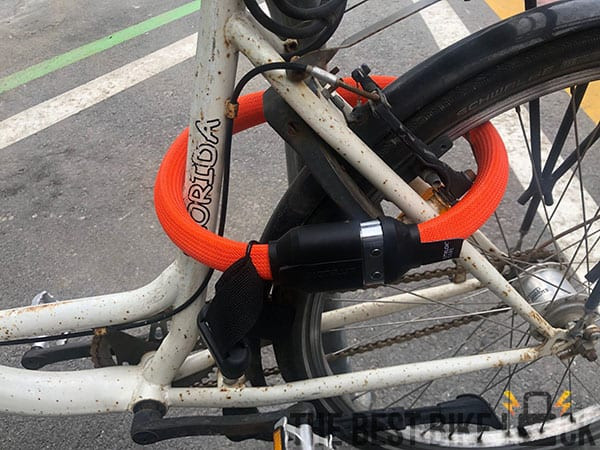 Litelok Core around bike frame and back wheel
Litelok Core around bike frame and back wheel
Litelok Core Plus securing a bicycle frame and wheel, demonstrating its wearable design and high-security features as a top-rated bike lock.
Liteloks use a material called “Boaflexicore,” a complex cable composite (distinct from typical cable locks). The Litelok Core Plus utilizes upgraded Boaflexicore Plus, specifically engineered to resist advanced cable cutters.
In reality, only an angle grinder is likely to cut through the Litelok Core.
What I appreciate most about the Litelok Core Plus is its belt-like wearability when not securing your bike. While not the first wearable bike lock – the Hiplok Gold chain also offers waist-worn portability – the Litelok Core Plus improves upon this concept.
Firstly, it’s more secure. The Hiplok Gold chain has a lower Sold Secure Gold rating and can be defeated by bolt cutters (ineffective against the Litelok Core). Secondly, the Litelok is lighter and more comfortable to wear around the waist.
Litelok Core Plus in a product shot, highlighting its award-winning design and innovative features as a wearable bike lock.
| Litelok Core Plus | |
|---|---|
| Waist Size | 22″ – 42″ |
| Weight: | 4.1 lb (1.9 kg) |
| Length: | 29″ (75 cm) |
| Other Security Ratings: |
It’s not without minor drawbacks.
Threading the Litelok end through wheel spokes can sometimes be awkward. While available in two lengths, waist-worn use limits you to the size that fits your waist.
However, no other Diamond-rated lock is as easily portable. Even the smaller Litelok Core provides a generous locking circumference for ample security options.
Waist-worn lock carriage isn’t for everyone (it can also be frame-mounted). But if it suits your style, the Litelok Core Plus is a highly secure and versatile choice. Read my detailed, hands-on review of the Litelok Core Plus.
How to Choose the Right Bike Lock for You
If none of my top 6 picks seem quite right, don’t worry! Read on, and I’ll guide you through 3 straightforward steps to guarantee you find the perfect lock for you and your bicycle.
As I’ve emphasized, the best bike locks not only protect your bike but also integrate seamlessly into your daily cycling routine.
Your individual circumstances are paramount: bike type, bike value, usage scenarios, and your budget all play a role.
It seems like a lot to consider, but breaking it down into these 3 steps simplifies the process:
- Choose the Right Security Level
- Choose the Right Lock Type
- Choose the Right Lock Size
In Step 1, we’ll determine your necessary security level and identify locks offering appropriate protection.
In Step 2, I’ll introduce various bike lock types and guide you in selecting the type best suited to your individual needs.
And in Step 3, I’ll explain how to choose the correct size lock for your bike type and locking preferences.
table of contents
Step 1: Choose the right level of security
Step 2: Choose the right type of bike lock
Step 3: Choose the right size lock
Which company makes the best bike locks?
Do bike thieves use lock picking techniques?
What’s the strongest bike lock?
What’s the lightest bike lock?
How can I protect my bike wheels and seat?
What’s the best way to lock my bike?
Ready? Let’s begin!
Step 1: Choose the Right Level of Security
A lock’s primary function is to prevent bike theft. Therefore, determining the necessary level of protection is the crucial first step.
However, simply choosing the strongest lock isn’t always optimal. Increased security often means greater weight and/or smaller size – usually both.
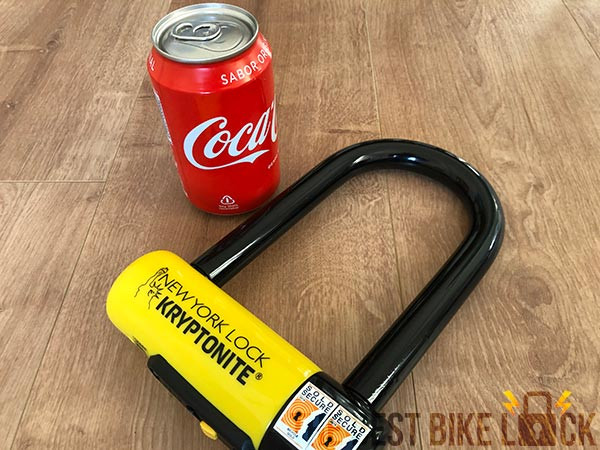 Kryptonite Fahgettaboudit Mini
Kryptonite Fahgettaboudit Mini
Kryptonite Fahgettaboudit Mini u-lock next to a can of soda, illustrating its compact size and robust build as a high-security bike lock.
A lock that’s insufficiently secure leaves your bike vulnerable to theft.
Conversely, an overly secure lock, exceeding your actual risk level, becomes unnecessarily heavy or cumbersome, hindering practicality. This might lead to less frequent or improper use, ironically increasing theft risk.
Matching lock strength to your actual risk level is essential. The easiest way to assess your risk is to answer the 3 questions in this quiz…
If you’ve completed the quiz, you’ll have received a recommendation for a Sold Secure Silver, Gold, or Diamond rated bike lock.
You might be wondering, “Who or what is Sold Secure?”
Who are Sold Secure?
Sold Secure is an independent organization that rigorously tests and rates bike locks and other security products based on their level of protection.
Sold Secure ratings range from Bronze to Diamond, indicating increasing levels of security for bike locks.
Bike locks are rated Bronze (least secure), Silver, Gold, or Diamond (most secure) based on their resistance to attack in the Sold Secure workshop:
- Diamond locks: “provide the highest level of security … intended for very high-value bicycles and e-bikes.”
- Gold locks: “offer the next highest level of security, aimed at mid-to-high value bicycles.”
- Silver locks: “offer a compromise between security and cost.”
- Bronze locks: “typically offer defense against the opportunist thief.”
Why Trust Sold Secure?
Sold Secure tests and rates more bike locks than any other organization. They employ standardized tools and methods informed by real-world bike theft techniques, including both brute force and lock picking.
They maintain close collaborations with law enforcement and insurance companies to ensure their testing remains current. Locks must be re-submitted annually for testing to maintain their rating.
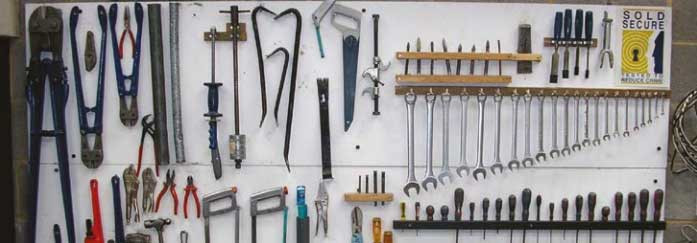 The Sold Secure Lab
The Sold Secure Lab
Inside the Sold Secure testing workshop, showcasing the rigorous environment where bike locks are evaluated for security ratings.
Many insurance providers require Sold Secure rated locks for bike insurance coverage, with coverage levels often tied to the lock’s rating. Without a Sold Secure rated lock, insurance may be void.
This collective evidence reinforces the reliability of Sold Secure ratings. They are experts in their field!
However, other security assessment methods exist, and considering them provides a more comprehensive perspective.
Other Independent Testers
Sold Secure isn’t the only independent body evaluating bike lock security. In the Netherlands, ART provides a similar service, rating locks from 1 to 5 (5 being the strongest) based on their resistance to attack.
ART employs a 1-5 star rating system, known for its rigor but evaluates fewer locks compared to Sold Secure.
ART’s ratings involve both machine testing (tensile strength, torsion strength, cutting, corrosion, dust, and freeze tests) and expert engineer assessments (brute force and intelligent attack tests):
- 1 star: Minimum security (“take-away security”)
- 2 stars: Bicycles
- 3 stars: Mopeds and scooters
- 4 stars: Motorcycles (on the road)
- 5 stars: Motorcycles (parked at home)
Sold Secure vs ART
ART tests and rates fewer locks than Sold Secure, with a narrower classification range. However, ART ratings, used in conjunction with Sold Secure, offer a finer-grained understanding of a lock’s security.
For instance, if two locks both hold a Sold Secure Gold rating, but one has a 2/5 ART star rating while the other has 3/5, the latter is demonstrably more secure.
This scenario is common and provides a useful method for further security-based lock differentiation.
Online Tests (are Questionable)
Numerous cycling and product review websites publish articles detailing their own bike lock attack tests, aiming to identify the “best” lock.
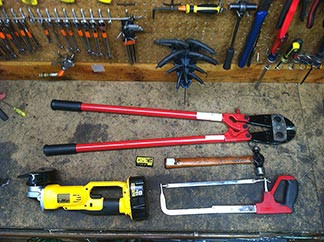 Lock testing tools
Lock testing tools
Various tools used for testing bike locks, illustrating the range of methods employed to assess security and resistance to theft.
These articles can be entertaining, but several factors warrant caution:
They test a limited number of locks, lack standardized tools and methods, and without insider knowledge, may not replicate actual thief attack techniques. Therefore, result reliability is uncertain.
Crucially: defeating a lock with a tool thieves don’t use is irrelevant. Thieves carry limited toolsets (cable cutters, medium bolt cutters, pry bars, angle grinders).
They typically avoid nut splitters, drills (outdated), and never pick locks!
Furthermore, these tests often neglect practicality factors (portability, ease of use), which are vital as there’s no “one-size-fits-all” lock.
Beyond broad generalizations like “cable locks are useless” and “angle grinders defeat everything,” their conclusions are often unreliable and less helpful than they seem.
Many recommendations on prominent websites are demonstrably flawed, eroding trust in these online tests.
Lock Brand Ratings (are Confusing)
Top lock brands have created proprietary rating systems to differentiate security levels within their own product lines.
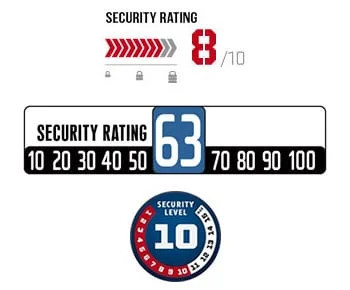 Different lock brand security ratings
Different lock brand security ratings
Security rating scales from Abus, OnGuard, and Kryptonite, highlighting the different systems used by brands to indicate bike lock security levels.
While useful for comparing locks within a single brand, these systems are incompatible for cross-brand comparisons due to their varying scales.
How I Use Sold Secure Ratings
The key takeaway: determine your risk level using the quiz. “High risk” scenarios necessitate Gold or Diamond rated locks. “Lower risk” situations may be adequately addressed by Silver rated locks.
| If your risk level is: | High Risk | Lower Risk |
|---|---|---|
| Your lock security rating should be: |
I advise against Sold Secure Bronze locks in any scenario due to their minimal practical protection.
While Bronze locks might suffice in extremely low-risk areas, I’m hesitant to recommend locks so easily defeated.
With the vast array of Silver-rated and higher locks available in diverse sizes, weights, and prices, finding one suited to your specific needs is achievable.
Step 2: Choose the Right Type of Bike Lock
This step is nearly as crucial as Step 1. Lock type directly impacts usability. A cumbersome lock will be used less, increasing theft risk.
Avoid locks that are excessively heavy, small, difficult to carry, complicated to use, or severely limit locking locations.
Optimal lock type depends on individual needs. However, examining the pros and cons of each type will clarify the best choice for you.
Four established bike lock types exist:
-
U-locks
-
Chain locks
-
Folding locks
-
Cable locks
Each type represents a trade-off between:
- Price
- Practicality
- Security
Note that u-locks, chain locks, and folding locks offer a reasonable balance of price, practicality, and security, while cable locks do not.
While cable locks may be cheap and easy to use, their security is minimal. Therefore…
Avoid cable locks!
To determine the best type for you, let’s examine each in detail.
U-locks / D-locks
U-locks (D-locks) are essentially oversized padlocks securing your bike to stationary objects.
| U-locks: pros and cons |
|---|
| – More affordable than chain locks – Lighter than chain locks – More secure than folding locks |
Good u-locks strike a balance between price, practicality, and security. They are generally cheaper, lighter, and slightly more user-friendly than chain locks, while still offering high protection.
Their rigid shape can make them less portable than chains, and their size limits the objects they can secure to.
However, for a single bike lock purchase, a u-lock is often the best general recommendation.
Prices range from around $30 / £18 for a decent budget lock to $300 / £300 for top-tier, highly secure models, accommodating various budgets.
Consider size and portability carefully before buying a u-lock.
The two u-locks recommended earlier are standard size, offering sufficient reach for most objects and bike types, making them widely suitable.
However, smaller u-lock sizes are increasingly popular. Let’s look at a notable example:
Kryptonite New-U Evolution Mini-7
The Evolution Mini-7 is Wirecutter’s top pick, a truly excellent lock, though not universally suitable.
| Kryptonite New-U Evolution Mini-7 | |
|---|---|
| My score: | |
| Check price: | > Check Amazon Price |
| Shackle thickness: | 13 mm |
| Weight: | 3.55 lb (1.61 kg) |
| Size (internal): | 3.25 x 7″ (8.3 x 17.8 cm) |
| Kryptonite rating: | 7/10 |
| Other Security Ratings: |
The Mini-7 has many appealing aspects. Its 13 mm shackle, made from Kryptonite’s strongest “max performance” steel, locks into the crossbar on both sides.
This enhances resistance to cutting and leverage attacks, reflected in its Sold Secure Gold rating.
It includes a cable for securing the wheel not protected by the u-lock and a decent frame mount (if properly installed).
More secure than the Kryptonite Kryptolok, it’s also lighter than the Litelok X1 and many other Gold/Diamond rated locks (weighing under 3 cans of soda without the cable).
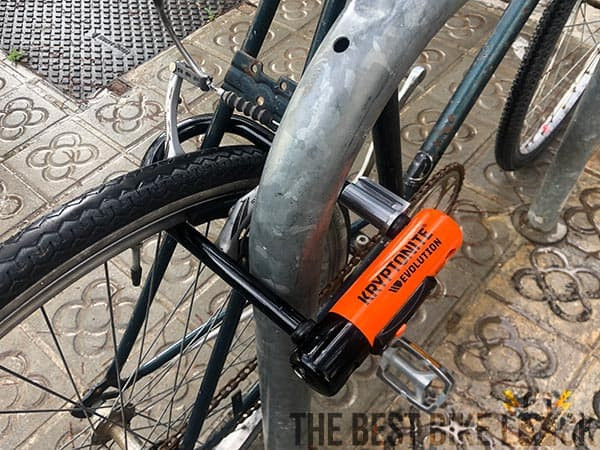 Kryptonite Evolution Mini-7
Kryptonite Evolution Mini-7
Kryptonite Evolution Mini-7 securing a bicycle frame and wheel, illustrating its compact size and practical application as a u-lock.
However, consider these points before purchasing:
Firstly, while Sold Secure Gold rated, its 2/5 ART star rating places it at the lower end of the Gold security spectrum. It’s secure, but not among the absolute best.
It offers no resistance against angle grinders.
Secondly, it’s a mini u-lock. Significantly narrower than standard u-locks, its use is largely limited to bike racks. Depending on your bike, locking it as desired may be challenging.
For example, bikes with wider tires or thicker frames might not fit within the lock’s dimensions when securing the frame, wheel, and rack.
However, with flexible locking techniques and willingness to adjust your locking method, this lock can securely protect any bike type on a rack.
I personally appreciate this lock’s effectiveness in my specific circumstances. However, its bike rack limitation makes a universal recommendation difficult.
Read my full review of the Kryptonite Evolution Mini-7.
Chain locks
Chain locks typically consist of a metal chain (sleeved to protect paint) and a large padlock.
| Chain locks: pros and cons |
|---|
| – More portable than u-locks – More versatile locking options than u-locks |
Chain locks can be broadly categorized:
- Portable chains: Light enough for daily carry.
- Stationary chains: Too heavy for portability, best suited for fixed locations (> 12 mm link thickness).
Portable Chains
Easily carried wrapped around seat posts or in bags. Their length and flexibility allow securing bikes to diverse objects.
However, these chains are typically ≤ 12 mm thick and less secure than good u-locks, while still being heavier.
Stationary Chains
Ultra-thick, core-hardened steel chains with high-quality padlocks offer maximum bike security.
Their weight and bulk make them best suited as secondary, stationary locks, left at frequent long-term parking locations.
Chain lock prices range from $45 / £40 for short, budget models to $500 / £200 for the thickest, heaviest options, making them generally pricier than u-locks.
As with u-locks, size and thickness are key considerations, as is portability if needed.
The Kryptolok and Evolution chains recommended earlier are suitable for portable security. Let’s examine the best stationary chain lock:
The Strongest Static Chain Lock: Kryptonite New York Legend 1515
While Pragmasis likely produces the strongest chains, their availability is limited. The Kryptonite New York Legend Chain 1515 is the most secure widely available bike chain lock.
| New York Legend 1515 | |
|---|---|
| My score: | |
| Check price: | > Check Amazon Price |
| Chain thickness: | 15 mm |
| Weight: | 15.95 lb (7.23 kg) |
| Length: | 60″ (150 cm) |
| Kryptonite rating: | 10/10 |
| Other Security Ratings: |
With 15 mm links, portability is not an option. This lock remains at your regular parking spot.
It boasts a 5/5 ART rating, a rare achievement! Available in 5′ and 3′ lengths, it can secure single or multiple bikes.
For ultimate security for your bike shed or other bike storage solutions, this is a fantastic, albeit expensive, choice.
Read my full review of the New York Legend Chain 1515. I also compare it to other chain locks as well.
Folding Locks
Folding locks consist of hinged metal plates connected by rivets. They fold compactly for transport and unfold to flexibly secure your bike.
| Chain locks: pros and cons |
|---|
| – Most portable type – More versatile locking options than u-locks – Relatively lightweight |
Generally slightly heavier than u-locks of comparable security, their length and flexibility offer more locking options than standard u-locks.
Their key advantage is compact folding for easy transport.
The carrying holster can attach via Velcro or, ideally, bolt to bottle holder mounts.
Abus Bordo folding lock mounted on a bicycle frame, demonstrating its compact and convenient portability when folded.
This compact form prevents loosening, swinging, or interfering with rides, issues sometimes encountered with u-locks.
Locking them can be slightly less convenient than u-locks or chains. Unfolding and maneuvering them around the bike and object can be occasionally cumbersome.
Their complex construction raises some durability concerns after attempted theft.
However, for users dissatisfied with u-lock frame mounts, folding locks are a great alternative.
Cable locks (are Useless!)
Cable locks typically consist of braided steel strands within a plastic tube.
| Cable locks: pros and cons |
|---|
| – Long reach – Lightweight – Inexpensive – Easy to use |
They are lightweight, flexible, and cheap. However, this flexibility makes them extremely vulnerable. Almost all cable locks are cuttable within seconds using handheld cable or bolt cutters.
Since cable cutters are a standard tool for bike thieves, cable locks offer minimal practical security.
Bike thieves specifically target cable locks. US and UK bike theft statistics [https://thebestbikelock.com/bike-theft-statistics-uk/] suggest that 90% of stolen bikes were secured with cable locks.
Avoiding cable locks drastically reduces your bike theft risk!
Cable locks can serve as secondary locks for wheels or saddles. However, better methods exist for wheel and saddle security.
Innovative Locks
Another category exists: innovative locks, often conceived by independent inventors and initially funded via crowdfunding platforms like Kickstarter.
| Innovative locks: pros and cons |
|---|
| – Address shortcomings of traditional locks – Utilize new technologies |
Unfortunately, many lack proven security credentials (a crucial aspect for security products) and haven’t been rated by Sold Secure or ART.
However, some have been tested and rated, warranting consideration, such as the titanium TiGr Mini and the textile Tex-lock.
Note that innovative locks are often pricier than warranted by their security level, best considered only if they address specific usability needs unmet by other lock types.
U-locks vs Chain locks vs Folding locks
My u-lock vs chain lock page details the pros and cons of u-locks and chains. Here’s a summary:
Portable Security
For everyday carry, u-locks are generally optimal.
Lighter, cheaper, and more secure than portable chains, they offer the best balance of security, practicality, and price.
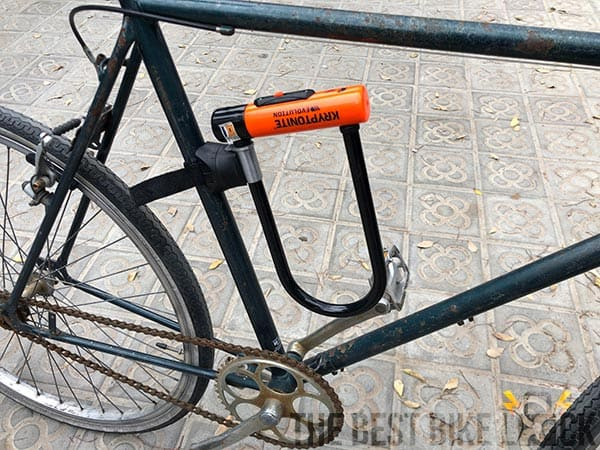 Kryptonite Evolution Standard
Kryptonite Evolution Standard
Kryptonite Evolution Standard u-lock mounted on a bicycle frame, highlighting its portability and suitability for daily use as a bike lock.
Valid reasons for choosing a chain over a u-lock exist. Perhaps you need more locking flexibility than a u-lock offers or dislike u-lock frame mounts.
But generally, u-locks are the best portable security choice.
Stationary Security
For fixed locations like home or work, a heavy chain is superior. Thick chains with strong padlocks provide the highest level of bike security.

High-security chain lock with a ground anchor, emphasizing its robust security and suitability for stationary use in bike storage.
They resist power tool attacks better, are bolt-cutter-proof (≥ 16 mm), and immune to bottle jack attacks. One chain can secure multiple bikes and works well with ground anchors.
Avoid carrying them for short trips!
What about Folding Locks?
Like u-locks, folding locks excel in portability. They address u-lock limitations: rigid shape and carrying inconvenience.
Their flexibility offers more locking options, and their compact folded form enhances portability. Weight is comparable to u-locks (often slightly heavier).

Abus Bordo Granit X Plus 6500 folding lock mounted on a bicycle frame, demonstrating its portability and practicality as a folding bike lock option.
However, high-security folding locks are less secure and more expensive than high-security u-locks. Limited brand choice (Abus, Seatylock, Trelock, Kryptonite) also restricts options.
If u-locks don’t meet your needs, consider folding locks before chains.
Step 3: Choose the Right Size Lock
Once you know your required security level and preferred lock type, size becomes the next consideration. Lock size significantly impacts usability, or even usability at all.
Ideally, we’d all use the smallest, lightest bike locks. This might suffice for slim road bikes or single-speeds in cities with abundant slim bike racks.
But what about bulky e-bikes, mountain bikes, or cruisers? What if bike racks are scarce, requiring use of lampposts, railings, or street furniture?
Larger bikes require larger locks!
Your bike locking technique also matters. Conventional wisdom dictates securing both frame and rear wheel with the lock. This demands a lock large enough to encompass both.
However, alternative wheel security methods exist. If your lock only needs to secure the frame, a smaller lock can suffice even on larger bikes. Plan your locking strategy before lock purchase.
Generally, larger bikes (e-bikes, mountain bikes, cruisers, city bikes, comfort bikes, tandems, BMXs) typically need a locking circumference at least as large as a standard u-lock (~85 cm).
Slimmer bikes (road bikes, hybrid bikes, fixies/single-speeds) may be compatible with mini u-locks and smaller folding locks.
However, individual circumstances are crucial. Careful consideration is recommended.
Which Company Makes the Best Bike Locks?
Having determined security level, lock type, and size, your search will likely present numerous similar locks from various brands. How to choose? Let’s compare three popular brands:
Abus vs Kryptonite vs OnGuard
My Abus vs Kryptonite vs OnGuard page (including a detailed review of “Anti-theft Protection” schemes) offers in-depth analysis. Here’s a summary:
Abus produces the highest quality locks. Well-made, extensively tested, highly reliable (even in harsh weather), and long-lasting. However, they are the most expensive of the three.
Kryptonite also makes high-quality locks, slightly below Abus in build, but compensates with exceptional customer service, including free key and lock replacement in certain situations and the best anti-theft protection schemes.
OnGuard has a somewhat weaker reputation for build quality and customer service. However, recent years have seen significant quality improvements. They consistently offer the lowest prices among the three.
For ultimate quality, choose Abus. For best value, OnGuard. For best customer service, Kryptonite!
Other Good Bike Lock Brands
Beyond the “big three,” numerous other worthy lock brands exist.
In fact, in 2024, my top 6 picks include more niche brands than established giants, with two locks each from Litelok and Seatylock (Foldylocks).
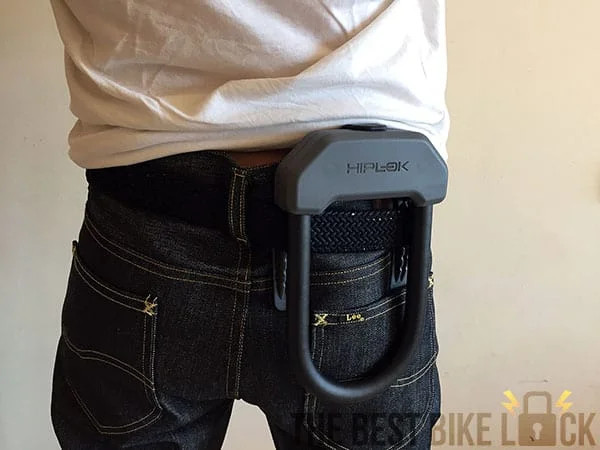 The Hiplok attached to my belt
The Hiplok attached to my belt
Hiplok DXC u-lock worn on a belt, showcasing the brand’s focus on wearable and portable bike lock designs.
Hiplok focuses on wearable bike locks, from waist-worn chains to belt-clipped u-locks, prioritizing convenient lock carriage.
Interestingly, innovation is largely driven by these smaller brands, though major brands are likely to catch up.
Making the Final Decision
Following my three steps should provide a solid understanding of the ideal security level, lock type, size, and brand for your needs.
If my top 6 recommendations aren’t perfect, browse comprehensive lists of Sold Secure Silver, Gold, or Diamond bike locks (based on your risk level), comparing sizes, weights, and prices until you find your perfect match!
How Much Money Should I Spend?
Generally, higher spending correlates with better lock quality. But what does “quality” mean in this context?
Primarily, reliability. Crucial for bike locks.
Avoid locks with keys that fail, mechanisms that jam, or shackles that stick. Lock malfunctions create major issues.
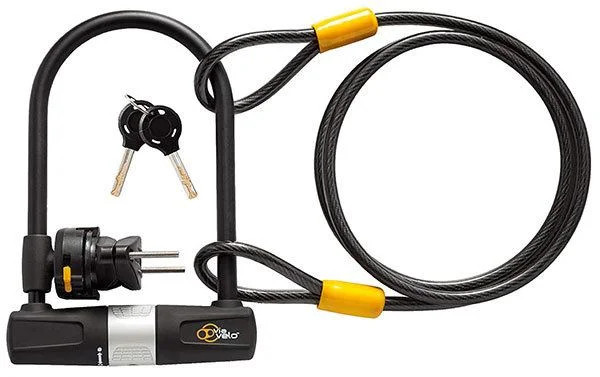 Cheap u-lock
Cheap u-lock
A budget u-lock, highlighting the importance of considering reliability and quality in bike lock selection, beyond just price.
Locks jamming while securing your bike render it unusable until professional removal (a nightmare). Failures before locking risk bike theft.
Higher-quality locks minimize these problems.
What about price vs. security? Affordable, high-security locks exist, and many expensive low-security options too!
But generally, high-security locks cost more. Reliable, high-security locks always cost more!
 How much money should I spend?
How much money should I spend?
An infographic prompting the question of how much to spend on a bike lock, advising investment in quality security for long-term bike protection.
Many brands suggest spending 10% of your bike’s value on a lock. But a $20 lock on a $200 bike is likely insufficient.
Spend as much as you can afford. This maximizes reliability and security, providing peace of mind.
Good bike locks last years and across multiple bikes. A good lock purchased now will still be valuable even if you upgrade your bike later.
Bike lock shopping isn’t exciting, and security costs are frustrating. But cheap locks are false economy.
Jammed locks require professional removal and replacement costs. Bike theft necessitates new bike and better lock purchases.
Learn from my mistakes: invest properly the first time!
Frequently Asked Questions
This final section addresses common bike lock questions, kept separate from the main article for conciseness. These insights may aid your decision.
Do Bike Thieves Use Lock Picking Techniques?
No, most bike thieves lack lock-picking skills. They don’t need them, as basic locks are easily defeated with brute force!
A small percentage may have basic knowledge and rudimentary raking tools. However, their limited skills and prevalence make it a negligible concern with a decent lock.
Celebrity lock pickers like Bosnian Bill and the Lock Picking Lawyer are highly skilled experts with specialized tools, filming in controlled lab conditions. Their rapid lock openings don’t translate to street-level theft.
While the Lock Picking Lawyer opened one of my favorite locks in 90 seconds (video below), he notes its “enough pick resistance to use in the street” because street thieves lack his tools and expertise!
[Video of Lock Picking Lawyer – needs to be embedded]
However, understanding lock mechanism types aids lock selection. Four common types exist: disc detainer, slider, pin tumbler, and wafer.
Disc detainer mechanisms, pioneered by Abloy and used by Abus and Kryptonite, are durable and pick-resistant.
Slider mechanisms, with keys featuring straight edges and internal teeth, are increasingly used by budget brands like OnGuard and Zefal. Pick resistance varies by implementation.
Pin tumbler and wafer mechanisms are generally less secure, susceptible to easier raking attacks. Wafer mechanisms are particularly vulnerable and best avoided.
What’s the Strongest Bike Lock?
The strongest bike locks are the Litelok X3 and Hiplok D1000. In my tests, the Litelok X3 slightly outperformed the Hiplok D1000.
Both offer incredible angle grinder resistance, practically angle grinder proof in most real-world scenarios.
However, both are very heavy and extremely expensive. The Litelok X1 offers a more practical balance for many cyclists. While slightly less angle grinder resistant, it’s far stronger than other locks on the market.
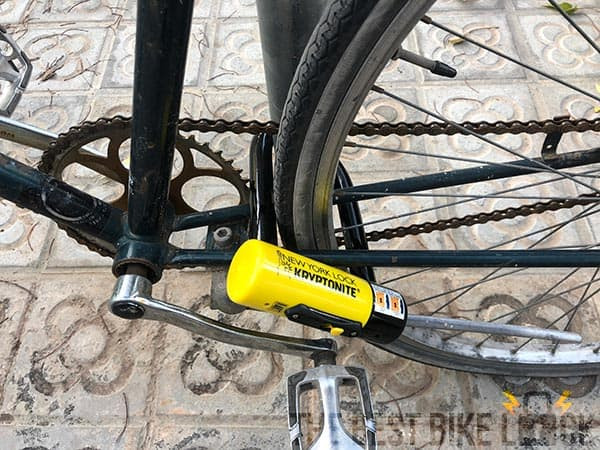
Litelok X1 securing a bicycle frame and wheel, reinforcing its robust security as an angle grinder resistant bike lock option.
Lighter, better-sized, and much cheaper than the other two angle grinder resistant locks, the Litelok X1 also includes a frame mount! See my Litelok X1 review for details and angle grinder test video!
My article on the strongest bike locks provides further insights. Remember, increased lock strength often means increased weight and/or reduced size, frequently both.
What’s the Lightest Bike Lock?
The lightest recommended bike lock is the TiGr Mini. However, this doesn’t guarantee it’s the best choice for you. Lightweight locks often compromise security or size, or are very expensive. “Lightweight” is also subjective for bike locks!
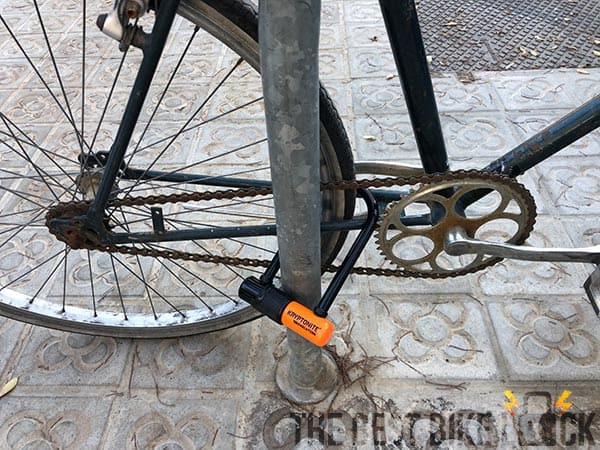 Kryptonite Evolution LITE Mini-6
Kryptonite Evolution LITE Mini-6
Kryptonite Evolution LITE Mini-6 u-lock mounted on a bicycle frame, highlighting its lightweight design and portability for cyclists prioritizing minimal weight.
As security is paramount, carefully compare weight, size, and price of “lightweight” locks to ensure the trade-offs are acceptable.
My article on the lightest bike locks provides further assistance.
How Can I Protect My Bike Wheels and Seat?
Bike wheels and seats can be secured with various devices: extra locks, cable lassos, security skewers, hex bolt blockers, and DIY methods.
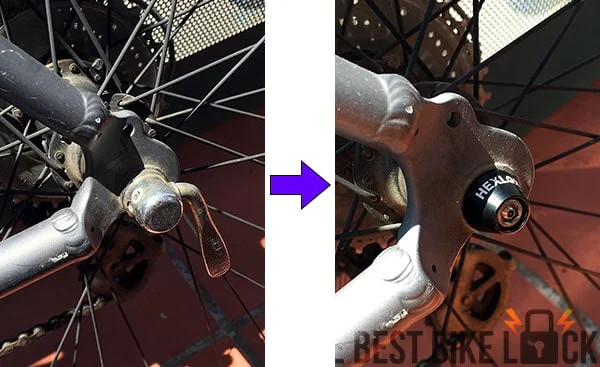 Hexlox wheel skewer
Hexlox wheel skewer
Hexlox wheel skewer, illustrating a component used for enhancing bike security by protecting wheels from theft.
My comprehensive article on securing bike wheels and seats explores all available options.
What’s the Best Way to Lock My Bike?
No single “best” bike locking method exists. However, numerous bad methods guarantee theft.
My extensive article on how to lock a bike covers both secure and insecure locking techniques. Reading it before final lock selection is highly recommended.
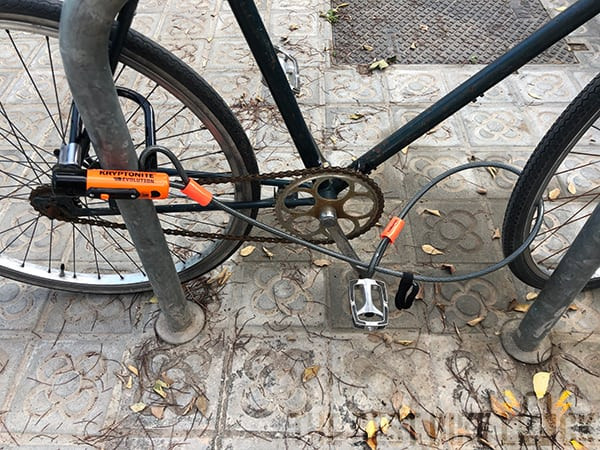
Kryptonite Evolution Mini-7 u-lock with cable, demonstrating a secure bike locking method that combines frame and wheel protection.
You’ll discover secure locking methods you might not know or considered viable.
Understanding proper techniques may allow you to choose a more user-friendly, smaller, and lighter lock, utilizing valid locking methods that maximize security with a smaller model!
This page contains affiliate links, which means I may earn a small commission if you click through and make a purchase. You will not pay any extra. More details here.
More Good Stuff:
Sold Secure Gold Bike Locks: The List
 Win a Free Bike!
Win a Free Bike!
Win a Free Bike!
How to lock you bike (properly)

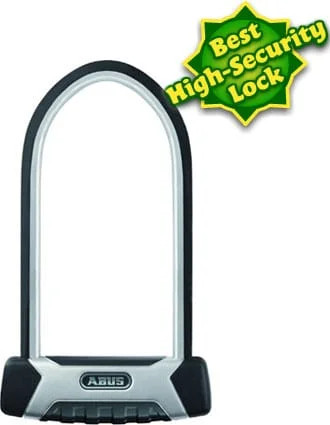 Litelok X1: Best Bike Lock
Litelok X1: Best Bike Lock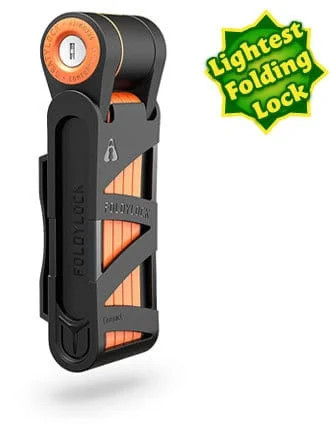 Foldylock Compact
Foldylock Compact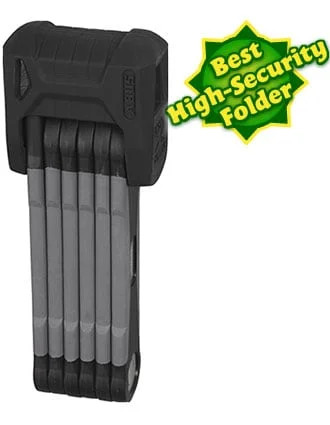 Foldylock Forever
Foldylock Forever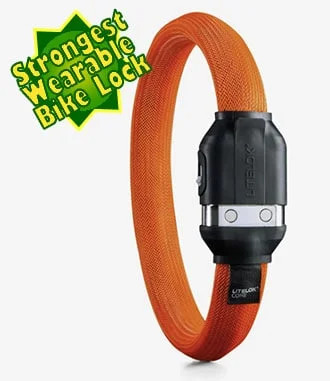 Litelok Core
Litelok Core